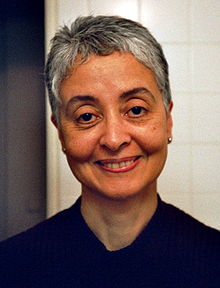Adrian Margaret Smith Piper (born September 20, 1948) is a first-generation conceptual artist and analytic philosopher who was born in New York City and lived for many years on Cape Cod, Massachusetts before emigrating from the United States. Since 2005 she has lived and worked in Berlin, where she runs the APRA Foundation Berlin. She taught philosophy at Georgetown, Harvard, Michigan, Stanford, and UCSD. Following in the steps of trailblazing pioneer Dr. Joyce Mitchell Cook, in 1987 she became the first tenured African American woman professor in the field of philosophy. For her refusal to return to the United States while listed as a Suspicious Traveler on the U.S. Transportation Security Administration’s Watch List, Wellesley College forcibly terminated her tenured full professorship in philosophy in 2008. Her principal philosophical publications are in metaethics, Kant, and the history of ethics. Rationality and the Structure of the Self was the culmination of 34 years of work, parts of which were previously published in article form. One early article, “Two Conceptions of the Self” (1985) introduced Piper’s distinction between the Humean and the Kantian conceptions of the self, motivation and rationality.
In Rationality and the Structure of the Self, she argues that the second half of the 20th century saw the development in Anglo-American analytic philosophy of a battle for supremacy between these two competing conceptions in ethics. Piper defines the Humean conception as consisting in the belief-desire model of motivation plus the utility-maximizing model of rationality; and the Kantian conception as modeling both motivation and rationality on the canons of deductive and inductive logic. The Kantian conception of the self thereby accords priority to freedom, autonomy and moral obligation over the satisfaction of desire and the maximization of utility. Piper claims that in this competition, both combatants have been handicapped by their own assumptions. In Rationality and the Structure of the Self she surveyed this historical development and proposes solutions to several of the still-unresolved problems it engendered.
Piper examined the Humean conception of the self in depth in Volume I: The Humean Conception. There she acknowledges the impressive historical pedigree of this conception in Hobbes, Hume, Bentham, Mill, and Sidgwick; and analyzes the foundations it provides to contemporary utilitarianism, virtue theory and social contract theory in philosophy. Piper also traces the influence of the Humean conception in economics, psychology, and political theory because of its technical formalization in decision theory and neoclassical economics by Ramsey, Savage, von Neumann & Morgenstern, Allais, and others. She argues that its wide sphere of influence in the social sciences has led late-20th century moral philosophers to presuppose the Humean conception as a given in constructing foundations for their normative moral theories.
She criticizes Humean moral philosophers for having displaced these problems onto a straw man: the consequentialist/deontologist debate, rather than confronting them head-on.With Rationality and the Structure of the Self, Volume II: A Kantian Conception, Piper aimed to remedy these oversights. She finds in Kant’s first Critique inspiration for proposed alternative models of motivation, rationality, and the self that are constructed on the relatively firm foundation of classical predicate logic – the same foundation on which Kant’s own conception of reason relied. She proposes a way to integrate standard decision-theoretic axiomatizations into this foundation without loss of predictive power, by rendering explicitly the intensionality of preference orderings using classical predicate logic; and extending the Boolean connectives and quantificational notation of that logic to subsentential constituents.Piper develops a conception of human agency, based on a foundation of logical consistency as literal self-preservation. She proposes two criteria of consistency for the set of concepts that rationally structure the self in the ideal case:horizontal consistency of cognitively operative concepts with one another, which applies the quantified law of non-contradiction to subsentential constituents; and vertical consistency of lower-order concepts with higher-order ones, which applies the quantified law of modus ponens to the inferential relationship among such constituents.
Influenced by the work of Sol LeWitt in 1967, Piper then embraced the principle of Conceptual art that accords highest priority to the idea or concept that generates a work, and regards different art media – painting, sculpture, drawing, performance, video, installation, soundworks, photo-documentation, etc. – as equally available and valuable instruments for realizing it. Since then, she has maintained this approach to materials in all of her work.
From 1967 to 1970, her early work as a first-generation Conceptual artist brought to bear the techniques and resources of yoga and meditation – what she called the “indexical present,” acquired through her personal practice, on the exploration of consciousness, perception, and infinite permutation using maps, diagrams, photographs and descriptive language.In the 1970s, Piper introduced issues of xenophobia, race and gender into the vocabulary of Conceptual art with her Catalysis (1970–72) and Mythic Being(1973–75) performance series. She then introduced explicit political content into Minimalism with her mixed media constructed environment Art for the Art World Surface Pattern (1976).
 |
| Decide Who You Are |
In the 1980s, Piper sharpened the focus of her artwork, by applying her meditational concept of the indexical present to the interpersonal dynamics of racism and racial stereotyping.
Adrian Piper founded the Adrian Piper Research Archive (APRA) in 2002, after being diagnosed with a chronic, progressive, and incurable medical condition. Although the condition had vanished within two years after she emigrated to Germany in 2005, she continued to develop APRA as a personal and public resource for students, scholars, curators, collectors, writers, and members of the general public who have a constructive curiosity or scholarly or professional interest in her work and life.
APRA is maintained as a document of Piper's activities in her three chosen areas of specialization: art, philosophy and yoga.
In 2009 Piper established APRA as a foundation that also funds the APRA Foundation Multi-Disciplinary Fellowship, a single, annual competitive research grant designed for intellectuals who (i) are proven high achievers in at least two seemingly disparate fields of scholarship and/or the arts simultaneously; and (ii) wish to use APRA’s resources to research the conception, constitution and/or structure of the self in either or both of them. Thus the APRA Foundation Berlin supports research that exemplifies, models, analyzes, and/or theorizes the same creative multi-disciplinary expressions of the self, encouraged by globalization and cross-cultural journeying, that her own work also embodies. The Fellowship picks up where Rationality and the Structure of the Self leaves off. It aims to extend and encourage further investigation into the same broad family of concepts and theories that Piper’s own research in philosophy and art engages. Its goal is to identify the constructive influence of cross-culturation and globalization on the development of divergent modes of creative self-expression; and to illuminate how these, in turn, help one to adapt to and flourish in that panoply of divergent cultures.






No comments:
Post a Comment